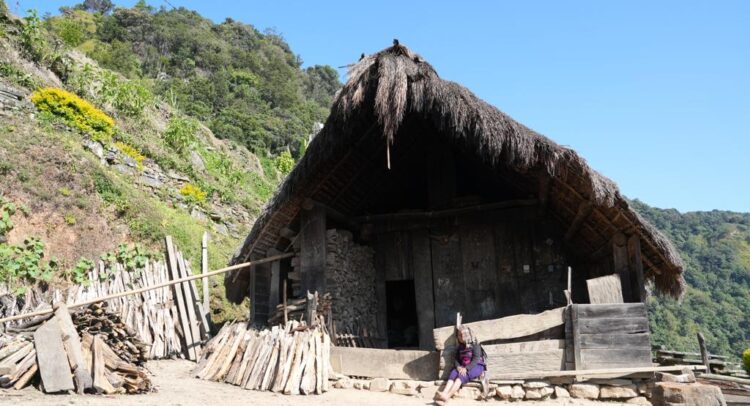
Asem Bhakta Singh, Reporter North East
Senapati (Manipur): Yangkhullen, nestled amidst the verdant slopes of Zeme-Naga-dominated Mountain ranges, exudes tranquility in the far north-western corner of Manipur.
In the midst of calm surroundings and a revitalizing atmosphere, villagers harbour a deep yearning for the government’s commitment to declare Yangkhullen as a heritage village, an assurance given by chief minister N Biren Singh when he visited the unique village on May 9 last year and also the fulfillment of several developmental promises he made to develop this ancient village under Willong sub-division in Senapati district.
Located about 135 Km from Imphal and 85 km from Senapati district headquarters, the peaceful village with a little over 2500 compact Zeme tribe population is far from the heat of the unceasing ethnic crisis gripping Manipur.
Zeme stands as one among the triad of Zeliangrong Naga tribes, alongside Rongmei and Liangmei. Yangkhullen stands as the least populous among Zeme villages within the state, as most reside in the Tamenglong district. As per the tribal elders, the collective population of Zemes in Manipur is estimated to hover around 15,000.
“Though Rs 3 crore was allocated through the Ministry of Development of North Eastern Region (DoNER) for preserving our heritage, regrettably, no tangible progress has materialized so far,” lamented the village authorities.
Chief Minister N. Biren Singh’s visit to the village last year sparked hope as he acknowledged the village’s allure, vowing to push the central government for the declaration of Ze-Mnui (Yangkhullen) Village as a Heritage Village. He assured comprehensive support and even promised aid from the Archaeology Department for preservation efforts.
The Chief Minister expressed dissatisfaction at the lack of substantial progress despite the substantial fund allocation. Consequently, he directed the deputy commissioner (Senapati) to compile a comprehensive report on the matter and cautioned of repercussions for any misuse of funds.
“We’ve pleaded for essential facilities such as a police outpost, roads, water supply projects, and the upgrade of our primary health centre to a community health centre,” recounted Hezeteing Zeme (43), the village chief highlighting the villagers’ demands presented in a memorandum to the CM.
Despite assurances from the CM, a year has passed without visible steps taken to fulfill these pledges, leaving the villagers disheartened. “We eagerly awaited the translation of our CM’s announcement into action,” said Hezeteing on Tuesday with a tinge of disappointment.
The village chief, responsible for settling internal disputes in accordance with tradition, lamented his financial constraints preventing the proper maintenance of his symbolic traditional house, a repository of Zeme culture, artifacts, and historical items.
“Due to the growing size of my family, we had to construct a new extension in the front without adhering to our traditional norms, owing to financial constraints,” he explained.
Being the 9th chief of Yangkhullen, the Chief highlighted the assortment of Zeme tribe artifacts—traditional pottery, furniture, garments, ornaments, weapons, and a peace treaty spear presented by the neighboring Maram Naga village, all housed and preserved in his residence. Among these treasures lie a colossal rice beer brewing vessel carved from a single massive log, close to 500 Mithun horns, and several deer skulls.
Regarding the spear’s significance, the Chief recounted a history marred by frequent conflicts between the Zeme and Maram tribes. Faced with escalating violence, animosity, and hostility, both sides resolved to cease hostilities. In 1976, the Chiefs and authorities from both villages convened, solidifying an enduring peace pact symbolized by the mutual exchange of the spear—a poignant gesture marking the end of strife.
“The exchange of a spear symbolized a historic peace treaty between Zeme and Maram tribes, ending years of animosity,” recounted the chief, highlighting the village’s rich history and heritage.
Preserving their indigenous religion, ‘Paupai Renet,’ centered around worshiping their deity ‘Tingrangfi,’ remains a priority for a few families, including Hezeteing’s, amidst the increasing sway of Christianity among villagers.
“The influence of Christianity has permeated the hill districts, enveloping nearly all indigenous tribes, save for a few, including our Zeme community in this village,” the chief shared. “Presently, out of the 450 Zeme households here, approximately 386 have embraced Christianity, while the remaining 64, including my own, steadfastly adhere to our traditional faith, Paupai Renet,” he explained.
“I am committed to perpetuating our heritage, identity, cultural legacy, and the age-old customary practices passed down by our ancestors. I will steadfastly uphold my indigenous religion for eternity,” affirmed the Zeme chief.
“Despite attracting tourists, researchers, and filmmakers, our village remains neglected,” Hezeteing remarked, pointing out the disparity between promises and visible development, citing the urgent need for action.
“It is quite disheartening to keep our village in shambles,” Hezeteing said while mentioning his inability to renovate his traditional house.
“Except for setting up five guest houses, a mobile tower, and a Zeme museum there has been no visible sign of development in our village and surrounding areas,” the chief said.
“We fervently implore the state government to implement essential measures, securing the ‘heritage village’ designation for Yangkhullen, as promised by hon’ble CM N Biren Singh. Additionally, we urge the government to initiate various developmental programs for our village,” Hezeteing appealed.
//


